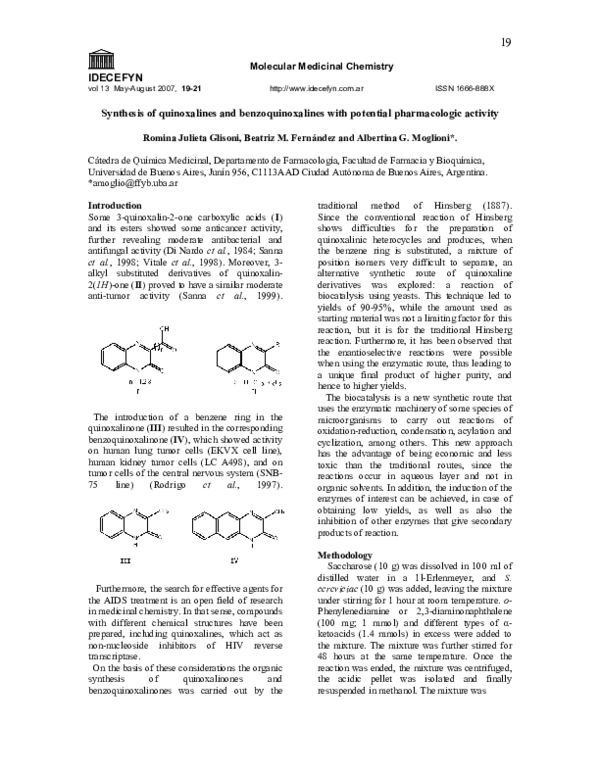Academia.edu no longer supports Internet Explorer.
To browse Academia.edu and the wider internet faster and more securely, please take a few seconds to upgrade your browser.
Synthesis of quinoxalines and benzoquinoxalines with potential pharmacologic activity
Synthesis of quinoxalines and benzoquinoxalines with potential pharmacologic activity
2007
Related Papers
American journal of organic chemistry
Synthesis, Reactions and Biological Activity of Quinoxaline Derivatives2015 •
Quinoxalines, a class of N-heterocyclic compounds, are important biological agents, and a significant amount of research activity has been directed towards this class. They have several prominent pharmacological effects like antifungal, antibacterial, antiviral, and antimicrobial. Quinoxaline derivatives have diverse therapeutic uses and have become the crucial component in drugs used to treat cancerous cells, AIDS, plant viruses, schizophrenia, certifying them a great future in medicinal chemistry. Due to the current pandemic situation caused by SARS-COVID 19, it has become essential to synthesize drugs to combat deadly pathogens (bacteria, fungi, viruses) for now and near future. Since quinoxalines is an essential moiety to treat infectious diseases, numerous synthetic routes have been developed by researchers, with a prime focus on green chemistry and cost-effective methods. This review paper highlights the various synthetic routes to prepare quinoxaline and its derivatives, cove...
Tetrahedron Letters
Synthesis of potential chemotherapic quinoxalinone derivatives by biocatalysis or microwave-assisted Hinsberg reaction2008 •
Organic Preparations and Procedures International: The New Journal for Organic Synthesis
Recent Developments in the Synthesis of Quinoxaline Derivatives by Green Synthetic ApproachesThe quinoxaline derivatives (4a,b) and (8) were synthesized by reaction of pyruvic acid and isatine with o-phenylenediamine and 3,4-diaminophenol. The synthesized quinoxalines were reacted with formaldehyde and 4-aminobenzoic acid to yield Mannch products (5a,b) and (9). Condensation of (5a,b) and (9) with o-phenylenediamine yield the quinoxaline benzimidazole derivatives (6a,b) and (10). All reaction carried out by using conventional method and heating by microwave.
2007 •
2013 •
A series of quinoxaline derivatives were synthesized by doing molecular modifications at C-3 methyl group of 2-hydroxy-3-methylquinoxaline nucleus. The synthesis was initiated by bromination followed by attachment of p-hydroxy bezaldehydes to 3-methyl group to synthesize 3(4-formyl phenoxymethyl)-quinoxaline-(1 H)-2-one as new intermediate and condense it with substituted aromatic amines to afford the synthesis of Schiff bases of 3-methylquinoxalin-2(1 H)-one. The new compounds (GG1, GG2, GG3, GG4 and GG5) have been synthesized by treating o-phenylene- diamine with ethyl pyruvate to yield 3-methylquinoxaline 2-one, which on bromination afforded the synthesis of 3-bromomethyl quinoxaline-2-one. Finally 3-bromomethyl quinoxaline-2-one was treated with 4-hydroxy benzaldehyde to yield the synthesis of 3-(-4-formyl phenoxy methyl)-quinoxalin 2(1 H)-one (GG1), which was treated with different substituted aromatic amines to yield the synthesis of 3-((4-(substituted-phenylimino)-methyl)-phe...
International Research Journal of Pure and Applied Chemistry
Recent Advances on the Synthesis, Reactions and Evaluation of the Pharmacological Properties of Quinoxaline, Quinoxaline-2-One and Quinoxaline-2,3-DioneThe review article attempts to give recent advances on quinoxaline and its derivatives. Some pathways to the synthesis of quinoxaline, quinoxaline-2-one and quinoxaline-2,3-dione were reported using simple reactive quinoxaline synthon. In addition, the reactions, biological and technological applications of derivatives of quinoxaline and related compounds were reported.
RELATED PAPERS
Erytheia: Revista de estudios bizantinos y neogriegos
From Orthodoxy to Greekness: Rupture in the "east2006 •
Lerner, K. Lee. "Ride with outlaws, Die with outlaws: Defacto antisemitism and antisemitism's allies." Taking Bearings. Scholars at Harvard (OpenScholar). April 23
Ride with outlaws, Die with outlaws: Defacto antisemitism and antisemitism's allies2024 •
American Journal of Qualitative Research
Introduction to Qualitative Data Analysis and Coding with QualCoderJournal of Ethnopharmacology
Ethnopharmacological approach to the herbal medicines of the “Antidotes” in Nikolaos Myrepsos׳ Dynameron2015 •
International Journal of Innovation and Applied Studies
Spatial and temporal variability of climatic parameters and its effect on drying up in Débo and Bô catchments (Department of Soubré, south-western of Ivory Coast)2013 •
ANZ Journal of Surgery
Frequency and predictors of axillary lymph node metastases in invasive breast cancer2001 •
Basic & Clinical Medicine
Cerebral Toxoplasmosis Diagnosed by Stereotactic Brain Biopsy Leading to Detection of Hiv Infection2016 •
International scientific conference Unitech 2022
Standards for digitalization and data archiving2022 •
IAEME PUBLICATION
ENHANCING CLOUD STORAGE EFFICIENCY AND ACCESSIBILITY WITH ARTIFICIAL INTELLIGENCE: A COMPREHENSIVE REVIEW2024 •
2015 •
2023 •
The International Archives of the Photogrammetry, Remote Sensing and Spatial Information Sciences
Dem Generation with WORLDVIEW-2 Images2012 •
RELATED TOPICS
- Find new research papers in:
- Physics
- Chemistry
- Biology
- Health Sciences
- Ecology
- Earth Sciences
- Cognitive Science
- Mathematics
- Computer Science

 Romina Glisoni
Romina Glisoni